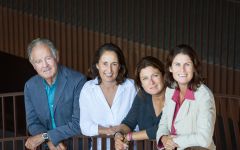Antinori Vinsanto (500ML) 1998

Product Details
Your Rating
Somm Note
Winemaker Notes
Other Vintages
2011-
Wine
Spectator








The Antinori family has been committed to the art of winemaking for over six centuries since 1385 when Giovanni di Piero Antinori became a member of the "Arte Fiorentina dei Vinattieri," the Florentine Winemaker’s Guild. All throughout its history, twenty-six generations long, the Antinori family has managed the business directly making innovative and sometimes bold decisions while upholding the utmost respect for traditions and the environment.
Today, Albiera Antinori is the president of Marchesi Antinori with the continuous close support of her two sisters, Allegra and Alessia, all actively involved in first person in the business. Their father, Marchese Piero Antinori, is the current Honorary President of the company. Tradition, passion, and intuition are the three driving forces that led Marchesi Antinori to establish itself as one of the most important winemakers of elite Italian wine. The company is one of the Founding Members of the "Associazione Marchi Storici d’Italia," an association for the protection, support and promotion of Italian historical brands.
The family’s historical heritage lies in their estates in Tuscany and Umbria, however over the years they have invested in many other areas, both in Italy and abroad, well known for producing high quality wine, opening new opportunities to appreciate and develop unique new terroirs with great winemaking potential. Each vintage, each plot of land, each new idea to be advanced is a new beginning, a new pursuit for achieving higher quality standards. As Marchese Piero loves to say "Ancient family roots play an important part in our philosophy but they have never hindered our innovative spirit."

For this look at Italian dessert wine, we will omit sweet sparkling options like Moscato d’Asti and Asti Spumante, which are covered in our discussion of Italian sparkling wine. We will also pass on sweet Vermouth and Barolo Chinato, both of which more typically serve as an aperitif or an ingredient in various cocktails. The country in fact produces hundreds of different sweet wines, but we will limit our focus to the following three classics.
One of the best-known Italian dessert wines is Vin Santo (“holy water”), produced in many parts of Italy but most widely in Tuscany, where it is commonly enjoyed after a meal with a type of biscotti called cantucci. Vin Santo is a passito wine, meaning it is made from grapes that have been dried for several months before fermentation, which can last for years. Typically, a blend of Trebbiano and Malvasia, Vin Santo can be made in dry or off-dry styles. But the best known versions are rich, complex and sweet, offering delectable notes of caramel, hazelnut, honey and dried apricot. Fortified examples do exist, but the finest are not fortified, coming in at 13%-14% alcohol.
Another passito Italian dessert wine option is Passito di Pantelleria, from the island of the same name. This of course is made in a similar manner as Vin Santo, although the passito juice is blended with fresh juice just before fermentation. But here the grape is Zibibbo, also known as Muscat of Alexandria. Beautifully aromatic as well as bursting with jammy flavors of figs, dates and apricots, this is lusciously sweet, and also about 14% alcohol.
Finally, we have to mention the fortified Italian dessert wine, Marsala. While commonly thought of today as a cheap cooking wine, Marsala at its best is remarkable. It is made from a variety of indigenous grapes grown near the Sicilian port city of Marsala and can be dry, semi-sweet or very sweet. The color also varies, with the three types being golden, amber and ruby – the latter actually quite rare. Another key variable is the amount of barrel aging, ranging from one year to ten. Production methods can also vary, but the most impressive types are made via a fractional blending process that is similar to the Sherry solera system. These Marsalas, especially those with five or more years in wood, offer tremendous richness and complexity to rival that of fine tawny Ports and oloroso Sherries.
